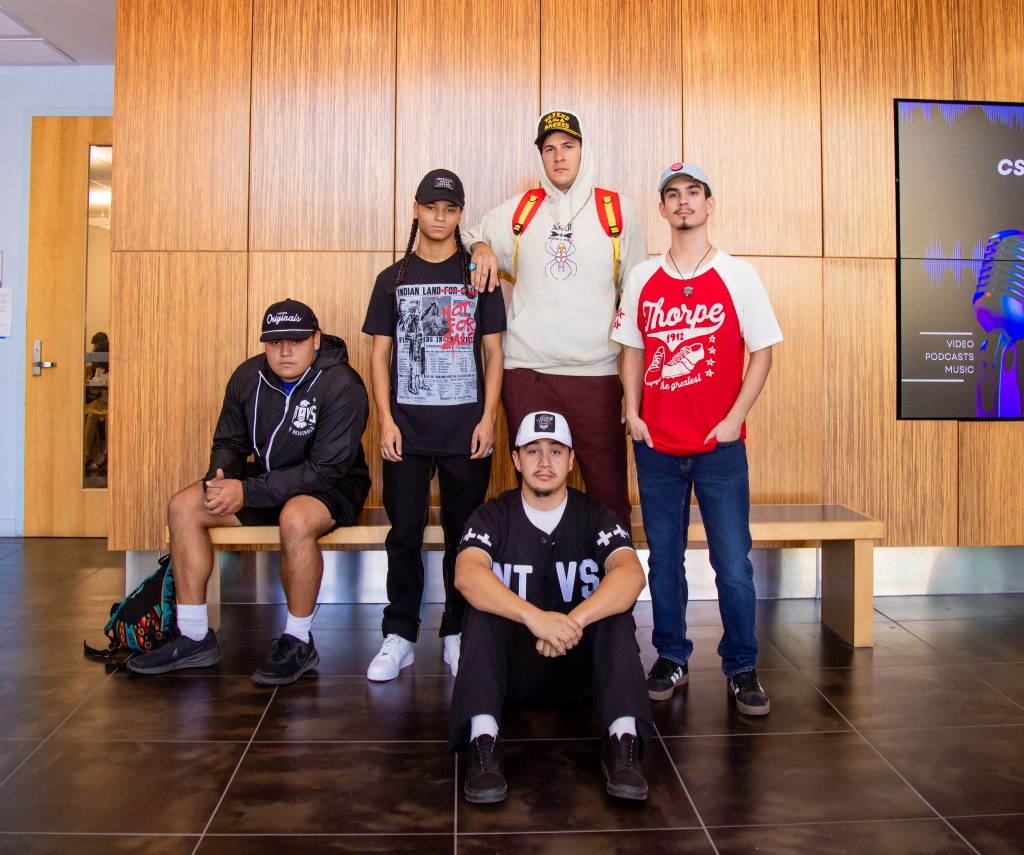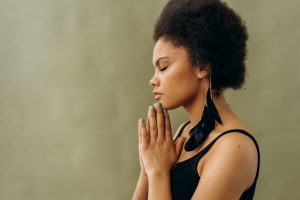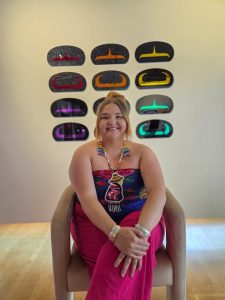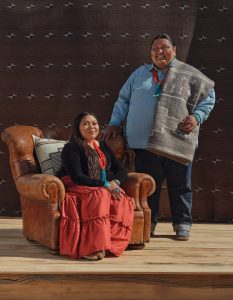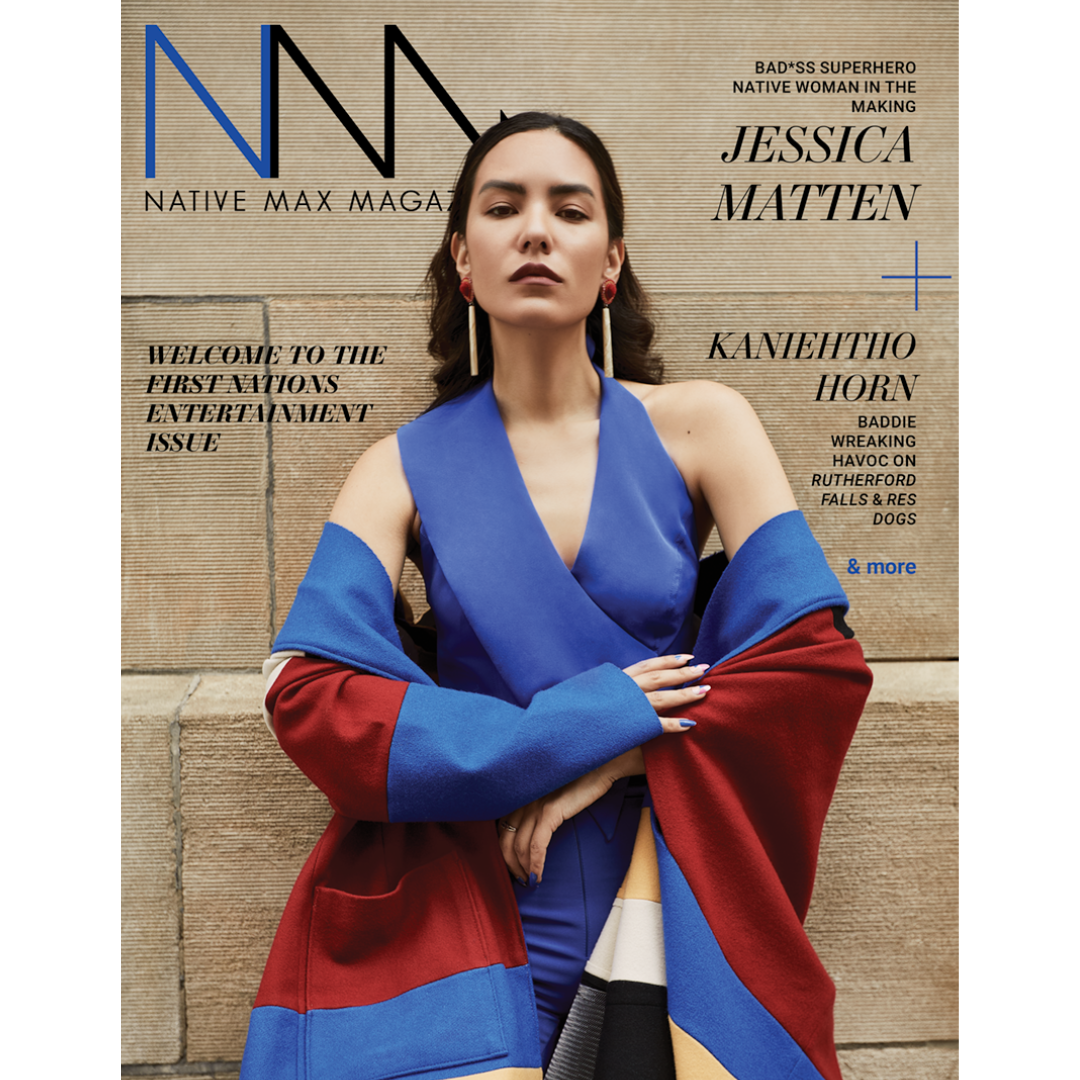Select a subscription plans
You need a subscription to access this content.
At California State University San Marcos, a group of remarkable Native American students is redefining what it means to excel in higher education. These students embody Indigenous excellence in every sense through their academic achievements, cultural pride, and dedication to uplifting their communities. From pursuing degrees in various fields to sharing their heritage through fashion, art, and activism, they are not only carving out paths for their own futures but also paving the way for generations to come. Their journey is one of resilience, strength, and a deep commitment to their people, showcasing the power of education as a tool for both personal growth and collective advancement.
CSUSM, founded in 1989 as the twenty-first campus in the California State University system, is a beacon of support for Native American education and cultural preservation. With one of the highest per-capita populations of Native American students among California campuses, CSUSM is dedicated to creating a welcoming and empowering environment for Indigenous students. This commitment is reflected in the university’s comprehensive Native American initiatives, which include a dynamic American Indian Studies department—offering both major and minor options and staffed by eighteen renowned faculty members—as well as the California Indian Culture and Sovereignty Center (CICSC), the Office of Tribal Liaison, and a Native Advisory Council. Additionally, the American Indian Student Alliance (AISA) has been recognized for its impactful work supporting Native students. Integral to CSUSM’s ethos is the incorporation of Payómkawichum culture and language across campus activities, fostering an inclusive environment that honors the land’s Indigenous roots. Among the distinguished faculty featured in this story are Dr. Joely Proudfit (Payómkawichum and Tongva), Chair of American Indian Studies and Director of CICSC; Dr. Eric Tippeconnic (Comanche); and Professor Dina Gilio-Whitaker (Colville), all of whom are pivotal in advancing Native representation and advocacy on campus.
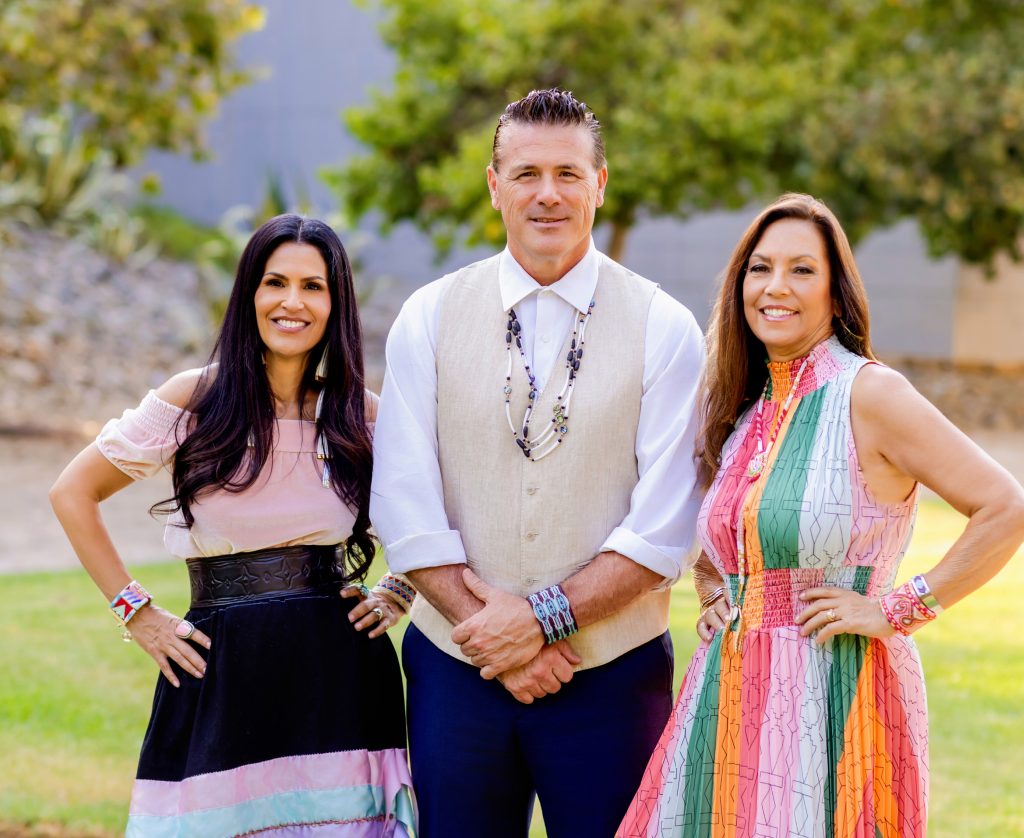
Dedicated to supporting Indigenous students’ academic success and cultural identity, the CICSC offers a space where students can find community, access resources, and engage in discussions about sovereignty, cultural preservation, and leadership. This center fosters a sense of belonging and provides crucial academic and emotional support that helps students navigate the unique challenges they face as Native scholars. With access to workshops, mentorship, and cultural programming, the CICSC equips students with the tools to thrive academically while staying connected to their heritage. For many, it becomes a foundation of strength, ensuring they can succeed at the university while honoring their traditions.
Through interviews with thirteen Native students, we explore their stories of resilience, profound personal growth, and cultural pride. From balancing the rigors of coursework to expressing their identities in ways that celebrate their Native roots, these students share why upholding their culture is essential. Each perspective reveals a deep connection to their heritage, illustrating how they navigate and enrich campus life while remaining grounded in the values and strength of their communities.
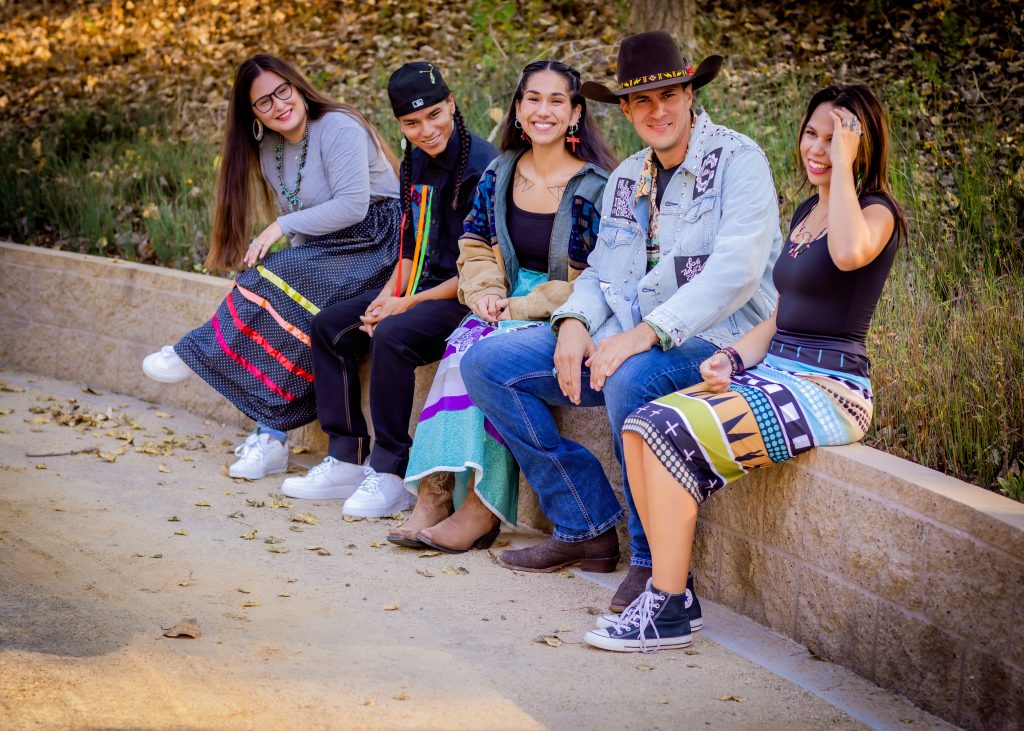
For these students, fashion is more than just clothing—it’s a dynamic form of self-expression and cultural affirmation. Many shared that wearing Native designers and Indigenous-inspired wearable art is a powerful way to connect with their roots and make a statement on campus. By choosing pieces that reflect their heritage, they not only showcase the talent of Native creators but also embody a message of pride and resilience. “Fashion can be a tool to encourage others to embrace their culture and not be afraid to represent their heritage,” one student reflected, echoing the sentiments of others who see style as a way to spark curiosity, foster understanding, and honor their communities in a visible, personal way.
Many of these Native students are also first-generation college students, a journey that carries both challenges and profound significance. Facing the pressures of navigating higher education without the guidance of family members who have taken a similar path, they often turn to one another for support and solidarity. The shared experience of being first-generation creates a close-knit network among them, where encouragement and understanding flow freely. For these students, earning a degree isn’t just about personal achievement; it’s about creating a legacy to uplift their families and communities, inspiring future generations to pursue their dreams. The struggles they encounter fuel a commitment to pave the way for others, making their presence on campus a powerful act of change for their futures and their families.
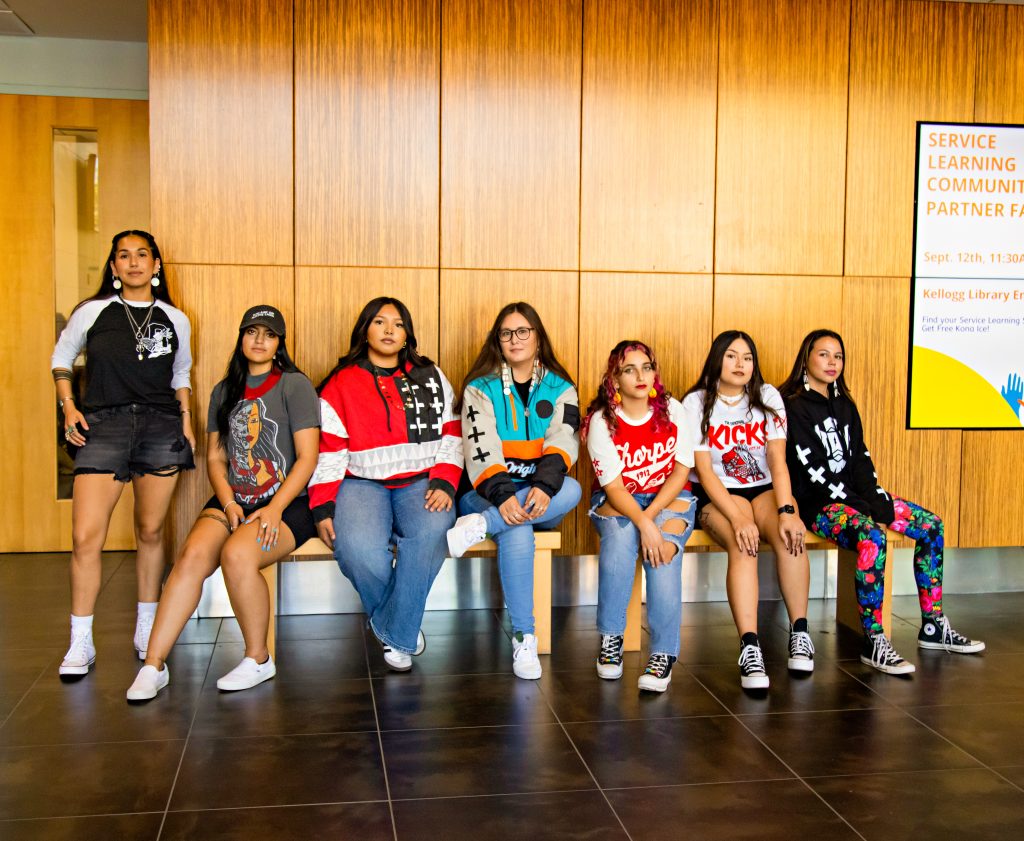
Personal Background and Inspiration
Can you tell us about your background and where you come from?
Alexandra Valle: My name is Alexandra Valle; I am currently in my fourth year at CSUSM, majoring in kinesiology. I intend to graduate next spring in hopes of pursuing physical therapy. I am a Kumeyaay Native.
Aiden Valverde: My name is Aiden Valverde. I am a descendant of the Iipay Nation of Santa Ysabel and am currently in my fourth year at CSUSM pursuing a degree in American Indian Studies. The field of work I am interested in is wildlife conservation. I am using the knowledge I have working with tribal communities like mine and others to help build relationships and grow the community in conservation. I have always been drawn to working in conservation and animal welfare, but I also always wanted to use my culture’s knowledge to help in the field. Throughout my life, I grew up wanting to pursue a higher level of education for my career, as I knew it would benefit me and my community. However, pursuing a higher education hasn’t always been as easygoing as some think. Throughout my life, I have experienced many challenges and hardships; however, I knew that growing up, I couldn’t let those obstacles change me or my future goals. I hope that after graduating and earning my degree in American Indian Studies, I will use it to help in wildlife conservation and build that passion and love in the community. I want to spread the knowledge I have learned to the younger generations so that when I am gone, the youth can carry on helping the environment.
Angel Jimenez: I am Kumeyaay from Baja, an area known as Santa Catarina, but I was raised with the Manzanita Kumeyaay and know more about their cultures and practices.
Chloe Wright: I am from Pechanga but grew up off rez in Fontana.
David Rivera: My name is David Rivera. I come from the Mesa Grande Band of Mission Indians.
Jaylee Martin: My name is Jaylee Martin, and I’m in my second year at CSUSM, majoring in communications and American Indian studies. I’m an enrolled member of Torres Martinez Desert Cahuilla Indians and a descendant of the Morongo Band of Mission Indians. Since a young age, I’ve lived on the Morongo reservation, attended their K-12 private school, and grown a strong connection with my culture and heritage.
Justin Littledeer: I grew up in Wauhillau, Oklahoma, a small community between Stilwell and Tahlequah in the middle of the Cherokee Nation. Stilwell, where I went to school, is the endpoint of the “Trail of Tears,” while Tahlequah is the capital of the Cherokee Nation to this day. I spent my formative and school-aged years mostly in Stilwell and then lived in Tahlequah after I became an adult. Growing up, there was Cherokee influence and presence all around me, including at home, and I am very blessed for that. There are also many other tribes living in northeastern Oklahoma, so if you pay attention, you can get exposed to quite a few different people and ways of thinking.
Kiara Flores: My name is Kiara, and I am currently 22 years old. I grew up around the Pala Indian Reservation in Southern California. I am a Kuupangaxwichem/Cupeno & Payomkawichum/Luiseño descendent with roots also from the Northern Ute Tribe of Fort Duchesne, Utah. I grew up local to my reservation, Pala. I went to school in the city but always stayed on the rez for sports, dancing, and cultural activities. My family grew up for many generations in Pala. Before 1903, my people resided in Kupa (now known as Warner Springs). I come from a strong family of women. My mother is Sonya Flores, and my grandmother is Leatha Diaz. I even got to know her great-grandmother, Carol Hutton, and met her great-great-grandmother, Lucielle Majado, before she passed.
Lanise Luna: Hi, my name is Lanise Luna, and I am Cupeño and Mescalero Apache from Sonora, Mexico. My mom is Kupa from the Pala Band of Mission Indians, and my dad is Mescalero Apache from Sonora, Mexico. I am a third-year student at California State University, San Marcos, majoring in Biological Sciences to become a Marine Biologist. I have lived on the reservation my whole life, and this experience has deeply shaped my perspective and values. Growing up in this close-knit community, I profoundly appreciate our cultural heritage and traditions. The sense of belonging and the rich history of our people have instilled in me a strong sense of identity and purpose. Living on the reservation has also taught me resilience and resourcefulness as we navigate the opportunities and challenges that come our way.
Miah Anderson: My name is Miah Anderson, and I am Diné. My family is from New Mexico, and my grandmother grew up on her reservation before being sent to a boarding school. After that, she returned to our reservation before moving to Flagstaff, Arizona, where most of my family lives now. I grew up in southern California after my mom and my dad decided to move. I have never lived on my reservation, but I have visited many times and kept in contact with my family and roots.
Virginia Aguilar: Miiyuyam(hello), my name is Virginia. I am 21 years old, and I am in my third year at CSUSM, currently majoring in American Indian Studies. I am a Payokawichum woman and member of the Paawma Reservation Tribe from my paternal side and Desert Cahuilla from Agua Caliente from my maternal side.
What inspired you to pursue higher education, and why did you attend California State University San Marcos?
Alexandra Valle: I will be the first in my generation to graduate college, and that was my biggest motivation. I don’t have a specific reason for choosing a CSUSM; I just didn’t want to leave too far from home!
Chloe Wright: I was in the foster system for 18 months as a kid, and I dealt with a lot of bad therapists, and I realized that we, as a whole, don’t have Native therapists in Indian Country.
David Rivera: The more I’ve gotten into my culture, the more disgusted I become. Our government has practically abandoned us; we are on our own. I want to help my tribe and my people all across the nation. We deserve to be better as a people, and I will fight for our lives to be better.
Jaylee Martin: I chose CSUSM because they have a strong American Indian Studies Program and a dedicated research facility that has helped me connect with more Native students who go through similar experiences.
Justin Littledeer: I wanted to go to school and try to create an easier life for myself, but I didn’t want to take on the debt required as an older student. So I enlisted in the Marine Corps, which eventually stationed me at Camp Pendleton, which is adjacent to Oceanside. After serving four years, my wife and I decided we liked the area, so we stayed here at least while I was in school. I started college at Mira Costa Community College in Oceanside, and through that school, I had a guaranteed transfer to CSUSM!
Kiara Flores: Ever since I was a young child in my huge family, they always told me I would be the one who goes to college and gets an education for the family. From that young age, I knew I would not let that idea down for my family. I was a child who stayed close to my grandma and great-grandmother on the reservation in Pala, and they had the most impact on who I’d become. They taught me to value things most people my age didn’t value, such as culture, language, hospitality, a clean home, the comfort of being home, and many other great values that kept me grounded. Having many great values from a young age made me realize I did not need much but a family who loved me and a bright idea of a future. My family always made me feel that all my values would follow as long as I went to school and continued my education. Being at CSUSM was almost a no-brainer. Being a 30-minute drive from my reservation, having lectures that are my relatives, and having people from your local tribal reservations surround me. At the same time, what I learned is something that I know I would not be able to find on any other campus.
Lanise Luna: I strongly believe in the value of higher education, which was instilled in me by my parents from an early age. My older sister excelled at CSUSM and is now a published author of two poetry books, while my brother pursued a career as a firefighter. I chose CSUSM because it offered a supportive environment that felt like a second home, and I was determined not to leave my family and live on my own.
Virginia Aguilar: I chose to pursue higher education to obtain the knowledge I could later bring back to my tribal community, hoping they could benefit from what I learned. I decided to attend CSUSM because it is local to my tribal community and many more, and it was a way for me to stay connected to my cultural roots.
How do you hope to use your education to benefit your community or people?
Chloe Wright: I want to do art therapy within Indian Country and offer beading, pottery, basket weaving, and other arts.
David Rivera: I want to motivate our people. I want to make a change on the reservations that need it most. I want to help the drug problem, poverty, and the produce deserts on reservations. I also want to motivate our people to vote. If all of us voted, this country would be a different place.
Emely Morales: As a non-Native student who has become a part of the center and AISA, I strive to carry on all the teachings and lessons I learned as a future educator to spread knowledge and awareness regarding the Indigenous community. While I can’t provide a deeper view, I can offer my experience and how these amazing people have helped shape my life and give me such an amazing experience on campus.
Kiara Flores: Being involved in my community and being around my local people always makes me constantly want to do and be better. From a young age, I have always found different ways to be involved, but as I got older, I realized how my education can play a huge role in how I can help my people and communities. Throughout my higher educational career so far, I have been able to start a beading club on the Pala reservation, start a weekly pow-wow practice class at CSUSM, and start an ambassador program. Being an Indigenous ambassador for the CICSC/CSUSM has shown me that my educational path impacts how I help my community. I hope far into my never-ending educational career, I change lives for people for the better. I hope to continue to inspire the younger generation of Native youth and walk that red road I was raised to do.
Lanise Luna: I’ve spoken to several Native professors at CSUSM, and they all conveyed the same message: “The world needs more Native researchers.” Since then, one of my main goals has been to continue pursuing the path towards becoming a marine biologist.
Sheyenne Ortiz: It’s expensive to exist, and our community has been mistreated, underserved, underrepresented, and undervalued for centuries. Being able to offer an open door to a resource, whether that be something I have/can do or get for us and others, is the goal. I’ll make enough to survive, but serving all my communities, Native or not, is my hope.
Resilience and Challenges
What challenges have you faced as a Native American student in higher education?
Angel Jimenez: Some of the challenges I have faced as a Native American is not being able to apply for scholarships because I am not an enrolled member. Here at CSUSM, we also do not have a student center, unlike the Latinx center or black student union; we are thankful to have the director of AIS allow us to use the CICSC as a center for Native American students.
Justin Littledeer: My assumption when I came into college was that there would not be that much Native presence at school, and for that, I would have to take trips home. Luckily for me, CSUSM has a robust American Indian Studies department with great faculty and strong support from the faculty and the other students who carved out a little slice for us on this campus. The American Indian Student Alliance has been great as a home base for me to have friends around who have similar experiences as me, even if we come from many different parts of the country.
Kiara Flores: As a Native Student on a non-Native campus, I feel I have faced challenges not often mentioned when it comes to the challenges of just any college student. As a Native student, I feel there are just many challenges we face as Native people that most professors/staff/faculty wouldn’t understand unless Native. Having to miss school for ceremonies, funerals, sweats, or even California Indian Day is just something that is not understood. Something that is also challenging about being a Native student in higher education is being a “token Indian.” Being in history classes as a Native student is always a challenge, having to either listen to the teacher teach the wrong thing or take matters into your own hands and correct and teach, which is what most Indigenous students end up doing.
Lanise Luna: As a Native American student in higher education, one of the main challenges I encountered was the lack of recognition for being a Native woman in STEM, compounded by the fact that the absence of encouragement from my community can be disheartening, especially when navigating a field where representation is already scarce. Ultimately, I hope to pave the way for future Native students by demonstrating the value of diverse perspectives in STEM and showing that it’s possible to honor one’s heritage while excelling in these fields.
Miah Anderson: Before I transferred to CSUSM, I attended a school where I had no representation. Since I was one of the only American Indian students at the school, I was used in cultural photoshoots, but I never heard from my university after the fact. It was difficult for me as I had never been in a situation like that, and it was incredibly disheartening as I had never been reached out to again. At the same university, there was nothing for American Indian students who attended, but there were cultural clubs for all the other students. It made me feel invisible. Since attending CSUSM, I have been grateful for the cultural representation at the university, the CICSC, and AISA.
Virginia Aguilar: The challenges I have faced as a Native American student in higher education are not feeling seen and not feeling like I belong this being because people still don’t think we exist even though our specific university lies on tribal territory. I have been able to overcome this by connecting with the CICSC and becoming a part of the American Indian Student Alliance; both of these have helped me find a sense of community and a home away from home, and I am now doing better than I ever have before.
How do you overcome these challenges and stay motivated?
Aiden Valverde: I have always thought of my family and community during challenges. I want to continue the work and passion that my people continue to do.
Chloe Wright: You find pockets of people with similar backgrounds and/or experiences.
Kiara Flores: Ever since I started college, I have been living on my own and staying motivated. Sometimes, it feels like there is no choice if I want to survive and pay all the bills. Staying motivated during hard challenges was tough, but what kept me motivated was being surrounded by people who truly wished nothing but success for me. Not only did I keep a close connection to the CICSC, but my own community of people and my family back home are always rooting for me. Having a support system from the rez to the city has made this journey easier than it could’ve been for me. Traveling to pow-wows every weekend is truly healing, and I believe that also has an impact on how I stay motivated for school.
Lanise Luna: I typically address the challenges I encounter by talking to the people at the CICSC. I know someone there has been through similar experiences, so venting to them is helpful. I stay motivated by focusing on my learning goal and not worrying about what others think because that’s the only reason I’m in class.
Sheyenne Ortiz: I have a lot of privileges that show up in various aspects of my life that other people within my community do not. Knowing when to step back and when to elevate instead of speaking is a balancing act but doable with communication and understanding that we’re growing together, not apart.
Can you share a story of a significant obstacle you encountered and how you overcame it?
David Rivera: Lack of representation; if we are ever represented, it’s often uneducated or stereotypical.
Emely Morales: Unfortunately, the research center where I work, which allowed me to be a part of this wonderful community, has also allowed me to feel and see discrimination towards the Indigenous community when it came to visitors to the center and harassment, and because I appear to be a Native student, it’s also at times directed at me. My peers in the center have experienced a lot of hardships when it came to these incidents. While it gave me a first-hand experience of these types of offenses, it also helped me better understand the impact of the colonized mindset I have been taught about here in the center.
Connection to Culture
How do you stay connected to your culture while being away from home?
Alexandra Valle: It is fairly easy to stay connected to my culture not only because of the CICSC but also because of AISA. Without AISA, I think I might’ve left CSUSM. Another thing is that I still live at home with my entire family, making it easy to stay connected.
Angel Jimenez: As a commuter student, I am thankful to live at home and stay connected with everything going on.
Chloe Wright: I bead and add my language where I can in my daily life, along with wearing the jewelry I have made.
Emely Morales: I am Mexican American; my parents immigrated here from Mexico. I have never felt oppressed or forced to feel any other way in the center, one of the most accepting places on campus. I am always free to dress and act as I normally do, offering my own food when doing potlucks and sharing my culture as they do. And because everyone here is so accepting and respectful, I feel so comfortable being me, which helps with being away from my family.
Justin Littledeer: I usually return home at least once a year and more if I can get away with it. For the last two years, I went home during the pow-wow season, which is always a blast. Last year, I went home for the Bell pow-wow in Bell, OK, and just at the beginning of this semester, I went home for the Cherokee National Holiday, which is not only a pow-wow but a whole weekend of cultural events and things to do. The best thing about either of those events is getting to be with family. Going home keeps fresh in my mind to remember where I come from. So even if I am all the way out on the coast, I still look back east to where it all started and where it continues to this day. I always say that you can’t understand Indian Country without including Oklahoma as a large part of that story. That comes up quite often in American Indian Studies courses as it is a place you really cannot afford to ignore if you want to understand Native history in this country.
Kiara Flores: I try to incorporate my language on a daily basis outside of my homeland. I’m thankful to attend a school very close to my homeland and be surrounded by my people, such as students who are related to me and faculty.
Lanise Luna: I stay connected to my culture while being away from home by going to the CICSC, being a student researcher there, and being a part of the American Indian Student Alliance.
Miah Anderson: To stay connected with my culture. I am actively involved with AISA and work at the CICSC. It helps to be surrounded by my culture and to be involved.
Sheyenne Ortiz: My mom keeps me connected; my name, Sheyanne, comes from her and her father. Even before moving onto the reservation with my stepdad, she was the gate to that part of me, of us.
Virginia Aguilar: I am lucky enough only to be commuting an hour away from the reservation I call home, but even with that, being a college student, I have a very busy schedule. But unlike most schools, we have a program where we do things daily that keep us connected to our cultures, such as beading workshops, pow-wow dance workshops, and tule boat workshops. We are fortunate; we get to be connected to our culture at CSUSM and learn about each other’s tribes and traditions.
Do you maintain traditions or practices at school to keep your cultural heritage alive?
Chloe Wright: I have pottery that I’ve made in my dorm as decorations.
Alexandra Valle: Yes! I constantly am bird dancing on campus.
David Rivera: I enjoy storytelling. It’s the easiest way of keeping our cultural identities. It’s also easy to do with non-Indigenous people because everyone has their own stories.
Kiara Flores: I bring many of my cultural traditions to school. It’s something I don’t think of doing; I just do it. For example, whenever we need to forage items such as elderberries on campus, I always lay down tobacco first. I use the wood to make dancing sticks. I’ve smudged off in the CICSC along with other students.
Another practice I have maintained on campus is a weekly pow-wow Practice/Workshop that began September 2023 and has been weekly since. The idea of starting a pow-wow practice/workshop began with me dancing around at the center or talking about pow-wows. I’ve always been open and shared many stories with people in the CICSC. Many expressed how they wanted to learn, so I knew what I had to do, and there began weekly classes. I opened this opportunity to the public, and many showed up from as young as two years old and as old as 65. Sharing the power of dance on campus has been healing and motivating in many ways for me. Having this piece of me on campus allows me to express many parts of my culture, mainly myself, where I am visible.
Lanise Luna: I practice my Native language on my own, but I know the CICSC gives all AI/AN students at CSUSM an opportunity to learn more about our culture through workshops, events, and even sometimes guest speakers. It is something I truly appreciate.
How do you balance your academic responsibilities with your cultural obligations?
Chloe Wright: A perk of being an AIS major is that you can attend school and still have those cultural ties often, even as classwork.
Kiara Flores: Having a balance between my academics and my culture is something I have learned to manage quite well. Managing my time is often something I need to do strategically. I always complete my homework before the weekend because I’m gone to a traditional gathering or a pow-wow every weekend. Not being home on the weekends taught me that I need to finish my work so that I can enjoy my time in my community. Keeping a balance between my culture and school comes hand in hand with each other. My AIS major keeps me engaged in my culture on campus and off. I also thank my husband for keeping me balanced while maintaining a healthy marriage. He keeps me grounded and makes me realize how much all of this is worth it in the end.
Incorporating Heritage into Daily Life
How do you incorporate your Native heritage into your everyday life at university?
Chloe Wright: I often wear the jewelry and clothes I have made or gotten over the years.
Kiara Flores: Fashion: clothing, bags, water bottles, etc. Bringing attention to issues in class. Indigenizing projects, assignments, etc. I had a dance final one time, but instead of contemporary dance, i did pow-wow dancing instead. Beading on campus and practicing pow-wow on campus. Being late to everything respecting the true and sacred “Indian Time,” ay! Studying my language on campus.
Lanise Luna: I incorporate my Native heritage into my daily life at school by wearing jewelry that I make myself. Wearing earrings that I have handmade makes me feel confident at school. When people compliment my earrings, I proudly tell them I made them.
Miah Anderson: I incorporate my Native heritage into my everyday life at school by implementing jewelry into my wardrobe. I always feel confident at school by wearing earrings and rings handmade by family and friends or from my reservation or fellow Indigenous artists and jewelry makers.
Virginia Aguilar: I incorporate my Native heritage into my everyday life at university by wearing and supporting Native brands, introducing myself in my traditional language in my classes, wearing my beaded jewelry, also having a lot of tribal tattoos that represent my tribes, and where I come from, and I am not afraid to show them they are apart of me and make me what I am.
Are there any specific cultural items or symbols you carry with you that hold special meaning?
Chloe Wright: I made these beaded sunflower barrettes for my high school graduation. I try to wear them often because my dad’s favorite flower was sunflowers, so I made those so he had a way to be with me for major events.
David Rivera: I wear belt buckles I inherited from my grandfather when he passed. I hold them very sacred. I also tend to carry sage with me.
Emely Morales: There are a couple of workshops we do at the center and for AISA, and I always love incorporating them in myself or my appearance, like the earrings I learned to make, which some of the people from the center helped me with, or even the denim jacket we decorated which has a lot of their incorporation.
Justin Littledeer: My walls at home are covered with my regalia, things I have made, or artwork my dad did. One of the first things he gave me was a fan, and he has the other matching wing fan, too. It hangs above my couch when I am not using it. When I am using it, it comforts me to know the other side of that eagle’s wing is back home, creating a connection between us no matter how far away from each other. My walls, in general, look like a snapshot of where I grew up, so every time I come home, it sets me at ease to be surrounded by things that keep me grounded in where I come from.
Kiara Flores: My tattoos are something I carry with me every day, and all mean something special to me. I designed most of my tattoos, which have been influenced by my culture and people. I also keep tobacco in my backpack whenever I need to offer to take something from the land.
How do your peers and professors respond to your efforts to maintain your cultural identity?
Angel Jimenez: Our professors and peers are very grateful for being able to bring bird singing to the campus. With bird singing, we have been able to accomplish many important events, such as our Native American halftime performance, our Native American day performance, and soon our AISA Social Gathering.
Alexandra Valle: They respond greatly; peers around me push me to intertwine my college and cultural identity.
Chloe Wright: That’s one of those things that very, from case to case, you get incredibly supportive people and the passive-aggressive ones or even just the flat-out wrong and racist people who are extremely misinformed.
Lanise Luna: When there is a chance in class, I will always take that as an opportunity to talk about my culture because it’s hard to connect with everyone on the same level, simply because I come from a different background than them. The CICSC is one of the most welcoming centers I have ever been to on campus; it felt like home. Everyone always encourages each other to participate, no matter where you come from.
Sheyenne Ortiz: I feel there’s less involvement by a lot of my non-Native peers in events or class overall, so I guess the inaction even to try to be involved in discussions about being Indigenous does hurt.
Fashion and Identity
What does fashion mean to you personally?
Aiden Valverde: Honestly, I love expressing my happiness with what I wear. Usually, I love to wear more Native clothing, but I wear clothes that show my love for wildlife and conservation.
Angel Jimenez: Fashion, to me, is a way of expressing or showing your personality and way of living without having to explain yourself.
Chloe Wright: I’ve never really been huge on fashion until recently when I started making beadwork to match all my clothes; I’m typically a band t-shirt kind of gal.
David Rivera: It means a lot to me. All my pieces of jewelry have a very deep meaning. I either inherited them from family members who have passed away or got them during a very important moment. Lots of my jewelry have Native representations on them. Most of these I’ve bought at pow-wows (gatherings).
Kiara Flores: Fashion means a lot to me. It’s often the first thing people will notice about me. Fashion is a form of self-expression that expresses my indigeneity. I feel like I cannot leave the house with a good pair of earrings, rings, necklaces, and a good fit, or else I feel naked. I can honestly wear pajamas when I leave my house, but you’ll never see them in pajamas and no earrings, that’s for sure. Fashion just doesn’t reflect what I wear, but my apartment is actually a reflection of my fashion choices as well. Comfy, cozy, and Indigenous.
Lanise Luna: Personally, I love fashion. I have always dreamt of becoming a model or creating my own clothing line. I was accepted into FIDM, a fashion school in LA, because I wanted to pursue a career as a fashion designer. However, I ultimately chose to study Marine Biology. Choosing to go the science route did not stop me from creating, though. I started my own craft business where I bead earrings, wristlets, and so much more!
Sheyenne Ortiz: I don’t wear a lot of jewelry, but the things I do have mean a lot to me. It’s nice having a piece of home or a person I miss with me everywhere. I never lost my childhood fascination with what dancers wear. I have flashes of pow-wows with my maternal grandfather where I was glued to his side the whole day, either held or in his lap, and it brings me back to that moment of peace.
Virginia Aguilar: Fashion, to me, is a way for everyone to express themselves. I feel like it’s also a first impression of how people can see you. You can tell a lot about a person but their fashion style. I like to express my cultural identity through fashion by adding different kinds of beaded earrings to my outfits, or wearing my basket necklaces or acorn necklaces.
How do you express your cultural identity through fashion?
Chloe Wright: I have found ways to make jewelry for all outfits, but there are very few that I have yet to have the time for.
Kiara Flores: I’m definitely the girl who shows up to class with a silver stone ring on each finger, four to eight silver, stone, shell, basket or beaded necklaces, at least two turquoise or beaded bracelets, and about ten ear piercings. A pair is reserved for the big beaded or shell earrings, dollar tree sunshades, an oversized jean jacket, a good fit with some dope shoes, and that’s the usual. I always have a Native print bag, my laptop, and my water bottle covered in Native stickers. My husband and I mostly own Native clothing besides my girly clothes. I stick closer to Native streetwear style with a touch of Cali Indian. Lots of times, I rock a Native shirt and jeans, but the accessories make the fit complete.
Lanise Luna: I showcase my cultural identity through fashion by wearing my beaded earrings and clothing from my brother’s brand, Stylish Culture Apparel. I usually wear earrings that I personally make, and it’s rare for me to wear earrings made by others.
Miah Anderson: I express my cultural identity through fashion by implementing patterns or jewelry into what I wear. It makes me feel close to my culture as I wear beaded earrings made by Indigenous artists or rings made by amazing silversmiths.
Are there any particular Native designers or styles that inspire your fashion choices?
Chloe Wright: I love Michelle Lunas’ designs. I found her through Instagram [@bitterwaterforredhouse], and she has beautiful Native formal wear.
Kiara Flores: Lauren Goodday (I got married on one of her dresses), Jaime Okuma (I modeled for her), N8TVS (we own almost all his shirts), Hustle Tribe (good streetwear), RoTree (my mother and I own about four of her ribbon skirts and my mom owns a fancy shawl regalia by her), and my grandma. She makes so much of my regalia, ribbon skirts, purses, etc. There are many artists that have inspired my fashion choices.
Lanise Luna: The biggest Native designer that inspired me was Jaime Okuma. I was doing research in high school and found her. I was immediately inspired and mesmerized by her work.
How do you think fashion can be a cultural expression and preservation tool?
Alexandra Valle: Fashion can be a tool to encourage others to embrace their culture and not be afraid to represent their heritage.
Chloe Wright: You can show many personalities and beliefs through your clothes. Don’t judge a book by its cover, but you can get a general feel for a person that way.
Justin Littledeer: It is important to be visible in our everyday lives. Especially because after all of these years and throughout so many different cultures spanning both continents, Natives do not look at all like what outsiders hold in their mind’s eye about us. We come in all shapes, sizes, and colors. Some of us wear beaded felt hats and boots, while others wear streetwear styles and everything in between. A strong desire to express ourselves is a common thread I see through many Native communities, whether that be through art, music, fashion, or any other creative medium. Regardless of what style Natives choose to dress in, whether in traditional attire tied to our specific culture or contemporary Native designs, nobody dresses better than Natives!
Future Aspirations
What are your goals after graduation, and how do you plan to achieve them?
Angel Jimenez: After graduation, I plan to continue my career in photography and help Native Americans be able to capture their culture through a lens.
Chloe Wright: I plan on being an art therapist in Indian Country and will probably try to get a start through HIS.
David Rivera: I haven’t pinpointed exactly what I want to do after graduation. But I want to be an activist of sorts. I want to change the way schools teach Native American history because, right now, it is outright deplorable. We need to change the fact that so many Indians never have the motivation to leave their reservations for a multitude of reasons. I also want to bring ballot boxes to reservations because our voices must be heard whether we like the U.S. Government or not.
Emely Morales: I plan on being a professor here on campus at CSUSM, teaching literature as an English teacher. I strive to get the highest level of education and help continue the teachings of my professors. Eventually, I would like to retire and teach college prep courses in high school, like Advanced Placement classes.
Justin Littledeer: My aim is to finish at CSUSM and continue law school. I tend to take school one semester at a time. So far, that has worked out well for me. If you focus on what you have to do now and get it done, you will be set up to take the next step when it is time. If I can pass this semester and achieve my goals within that small timeframe, I can move on to do that for every other following semester. If you stay grounded on the here and now, then the worry of “later” will naturally not bother you so much because you are already doing the things right now that will make that “later” possible.
Kiara Flores: I have many goals after graduation, and being done with school is not one of them. As soon as I graduate, I plan to stay at CSUSM to get my Masters in Social Work. I know that if I made it this far, I can keep going with how young I am. I want to build security for my husband and me, and being the first in my family to graduate, let alone attend college, has been a huge accomplishment and change for my family and future family. After I get my MSW, I want to teach the University’s American Indian Studies courses. I love teaching and found this out through teaching pow-wow dance to the community.
Lanise Luna: My goal after graduation is to work at an aquarium. I want to get that one-on-one experience with the animals because having a relationship with the animals is very significant. To achieve this goal, I am proudly honored to know Dr. Joely Proudfit because she has set me up with so many opportunities with Native faculty who are involved with ocean conservation or know people who work along those lines. I can also achieve this goal by utilizing the NARCH program for Native college students in STEM.
Miah Anderson: I plan to attend a DPT (Doctor of Physical Therapy) program after graduation. I want to be a physical therapist and plan to achieve this by graduating from a DPT program. It is rigorous to get into, but I plan to have high grades, to have fulfilled my internship hours, and have a high GERD score. After DPT school, I plan to work in hospitals and with athletes within my community.
Sheyenne Ortiz: I plan to go to law school to continue my education after CSUSM! I want to attend a local school so I can stay close to home, but we’ll see where I’m led by life.
Virginia Aguilar: My goals after graduation are to attend ASU for a year for their Indian Gaming and Tribal Self-Goverance program, and then I hope to come back to my tribe and start up programs for our youth and elders and hopefully become a more permanent cultural teacher for our youth. I also hope to join the tribal council by starting as a general council member with my end goal of being my tribe’s first Chairwoman. I plan to achieve these goals by staying focused and determined and leaning on my tribal community when I need help.
How do you see your education and experiences shaping your future contributions to your community?
Chloe Wright: I hope to make a difference within my community by working with them and fostering Native youth.
Advice and Inspiration
What advice would you give to other Native American students considering higher education?
Alexandra Valle: Do it! I know it’s easier said than done, but I was in a position where I didn’t know how college would pan out for me being a first-generation student. Now, I am close to graduating, cheer for the team at San Marcos, and have found a support system that I can call family.
Angel Jimenez: I would advise students wanting to pursue higher education: “Be sure to pay attention and stay determined; just because you paid for it doesn’t mean you try when you want.”
Chloe Wright: I know it’s nerve-racking leaving your community, especially those of us who lived in that bubble your whole life, but you will find your people wherever you go.
Justin Littledeer: Take school seriously, go to class on time, and turn in your work. It sounds simple, but my college experience has been that if you just show up and do what you are supposed to be doing, even when you run into trouble, people will be willing to help. I suggest finding like-minded people to lean on and be friends with. It can feel pretty lonely being a Native on campus, but you can fix that by joining organizations or clubs with people that you can relate to. It has been so helpful to me that I suggest factoring in what kind of clubs and departments a school has before going there, especially for undergraduates. Take a peek at a school’s website to see what kind of Native presence they have on campus, and reach out to those departments and clubs before deciding where to go to school, especially if you have multiple schools on your radar. I would also say, that if you are in an area that doesn’t offer much in that regard but still want to go to school, you can do it! Somewhere in your people’s past, there is a Native that has endured far worse than a few years at a college, so don’t be discouraged; you can do it!
Kiara Flores: Our people need to be placed in these spaces that require degrees. Oftentimes, what keeps us Natives between the changes is a position that requires degrees. Our people must make changes from the inside to create a better future for the next seven generations. To me, it’s important to share how much I value education and how much it has changed the route of my life for the better.
Lanise Luna: I would tell other Native American students considering higher education to just go for it. The rez will always be there for you when you come back. I highly encourage them to just reach for the stars because I was once that little rez girl who thought she wasn’t good enough for college just because she was on the rez.
Virginia Aguilar: It is not easy, but they are capable of anything they put their mind to. We come from a powerful line of resilient ancestors, and obtaining a higher education is proof of living resilience, and we are our ancestors’ prayers. I would also say to connect to other Native peers and outlets. Having a strong school community sets the foundation of your school career.
How can educational institutions better support Native American students in their academic journeys?
Chloe Wright: By Hiring more Native advisors who understand where the students are coming from.
David Rivera: Admitting we still exist! In all my years of school, not once did we talk about Native Americans’ lives today. The way they put it was like we were all dead. And that’s what they want people to think. The extermination of the American Indian never ended; it just took a new form.
Emely Morales: I would say make them feel heard, seen, and important, just like the rest of the school. Give them a place like the support center, just like here at CSUSM with the CICSC that allows the American Indian Studies staff and students to feel connected and offers them support and resources to better their education.
Lanise Luna: I wish educational institutions were more mindful of us. I feel like they always try to test limits and see how far they can push you around until you do something, but I think that AI/AN students should have at least 5-10 rooms set aside if they need to live in the dorms. A lot of Native kids will get discouraged if they’re put on the backburner by the university.
Who or what has been your biggest source of inspiration throughout your educational journey?
Alexandra Valle: My family, honestly, I always want to make them proud and show my younger cousins that graduating from higher education can be done.
Chloe Wright: My biggest inspiration was my great grandfather who always said, “Shut up and be curious,” along with constantly pushing for his children and grandchildren to go on to higher education and to not rely on the money we get because it could be gone in the blink of an eye.
Kiara Flores: My husband, Mi’De, has been my biggest source of inspiration throughout my educational journey. I met my husband in my second year of college, and he changed my life from that moment. I instantly became motivated, got more involved in my community, and became a better person. Being inspired to better myself for the next seven generations means much more to me. Knowing I have to build a good future and earn degrees is so important to me now that I’m older and married. I know I need to build myself before I start anything new, and my husband is always by my side.
Lanise Luna: My parents have been my biggest source of inspiration throughout my educational journey because of their unwavering support, guidance, and belief in my potential. They’ve always been there to celebrate my successes and encourage me through challenges. Their dedication to their own work and learning has shown me the value of perseverance and hard work. They’ve taught me to approach problems with a positive mindset and to see every challenge as an opportunity for growth. Their faith in my abilities has been a driving force.
Sheyenne Ortiz: My professors have been major inspirations! Seeing a reflection of yourself in the real world is detrimental for children, but our mainstream representation has been morphed with harmful stereotypes, so having people now who are willing and want to share/teach us is incredibly meaningful!
Virginia Aguilar: My biggest inspiration throughout my educational journey has been family and younger siblings, specifically my tribal youth. They look up to me so much and are so proud of what I do. Knowing that I have inspired them to want to break through generational barriers is all the motivation I will ever need to keep going.
Final Thoughts
Is there anything else you’d like to share about your experiences or connection to your culture?
Aiden Valverde: I feel extremely connected to my family and community, and they continue to push me through school and the challenges life presents. To be so welcomed and at home with my community always fills me with so much pride and happiness that I can never fully express.
Emely Morales: I started working at the CICSC in my second semester of freshman year and wouldn’t change my decision. I have been allowed to be a part of an amazing community and make friends from all sorts of different backgrounds and representations. I have never met a more accepting and diverse group of individuals here to support and care for each other. We have fun, make memories, and spread awareness to better the circumstances of the Indigenous community, and if I have the chance to work here on campus in the future as an educator, my efforts to support and connect with the center will continue.
Sheyenne Ortiz: I think it’s important, especially in a country built by immigrants (to the detriment of the Indigenous population) and one that holds people from every part of the world. We’d ideally have every community represented in every room, and while not plausible, it’s so important to be loud and persistent when we’re not in a room or being listened to. It’s important to know being corrected is not bad; being wrong is not bad, and it’s how you choose to move forward when a judgment can be made on whether someone will continue to be ignorant or absorb, reflect, and learn.
How do you see the role of Native American students evolving in higher education in the coming years?
Angel Jimenez: I see the role of Native American students becoming very big in the universities as the students begin to talk about their cultures more and do more and more events.
Chloe Wright: I would love to see more of us going off to school and bringing those skills we learn back to our community.
Kiara Flores: I know our future is bright. I see our people attending school more, continuing their education, and wanting to have careers. This is something I notice because this is what I see on my campus, and I see many people on my travels to pow-wows and gathering how others my age are also in school or going to soon. I come from a family who never attended college, like most other people in my community, but this is a common pattern I’ve seen locally. I’m proud to be part of the change and hope to see it last and grow.
Miah Anderson: I hope to see more American Indian students in higher education and advocate for our youth the importance of attending school. Personally, I have seen more youth becoming interested in going to school, and I think that in the coming years, there will be more representation.
Virginia Aguilar: I see the role of Native American students evolving in higher education in the coming years by seeing a major increase because I am already seeing it now in my generation. We are finally realizing that we are not the stereotypes that we have been made out to be and that we can attend big universities and get higher education.
What message would you like to convey to readers about the importance of education and cultural preservation?
Chloe Wright: Without the ties to our culture, such as language, we lose all sense of ourselves, and the U.S. wins because that means they have finally erased us.
David Rivera: We need to be educated. If we’re not educated, people will keep the stereotype that we’re drunk Indians. We need to let people know we’re here to stay. And by being educated, it is easier to be heard. We need change in the public school system now. I’m tired of people being in shock when I tell them I’m an Indian because they didn’t know Indians were still around. But I don’t blame them! It’s not that they’re ignorant; our school system has failed them. We need to be heard and make a change.
Justin Littledeer: I would love to see more things written by us rather than about us from outsiders. We are already starting to see a change there in the landscape of today’s media, and we have an opportunity to be a part of that more and more. Stop letting people who only know about Indians from that time they drove through Albuquerque or Tulsa tell the world about who we are. We can tell the world who we are just fine.
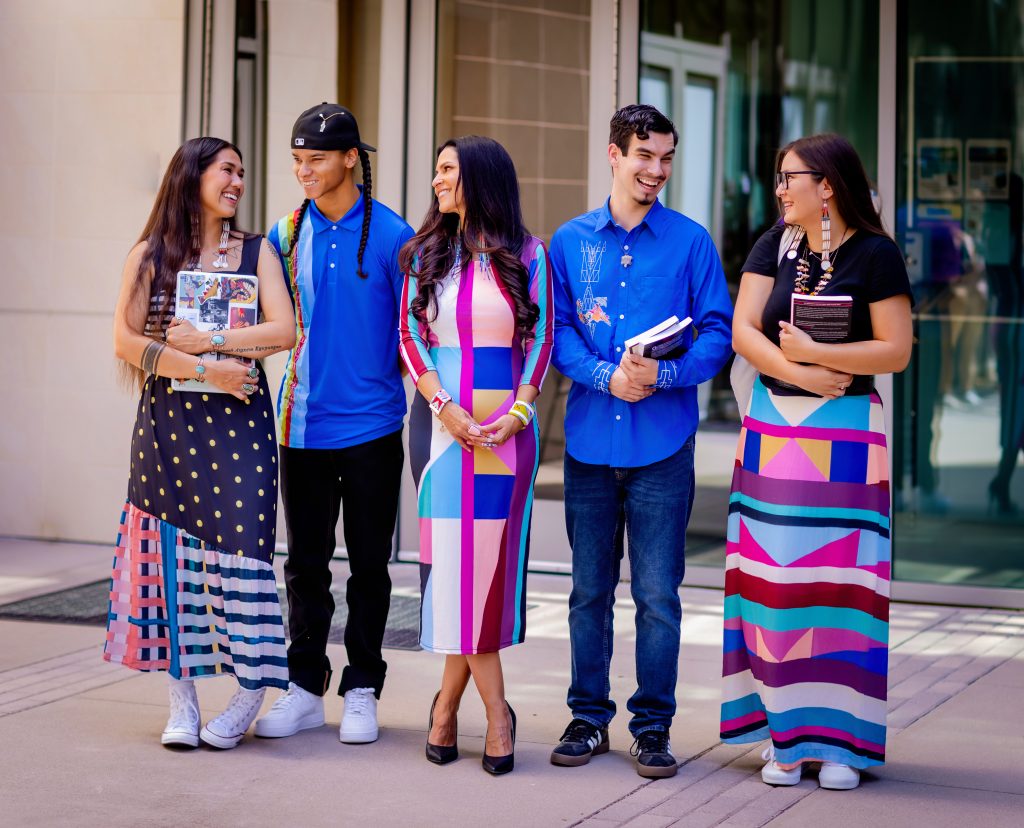
The stories of these Native American students at California State University San Marcos are a testament to the power of education and cultural pride. By embracing their identities and striving for academic success, they are transforming their lives and creating a ripple of change that will impact their families, communities, and beyond. Their dedication to preserving and promoting their heritage while pursuing higher education reflects the potential for greatness that exists within Indigenous students everywhere. As they continue their educational journeys, they carry with them the strength of their ancestors and the vision of a brighter future, proving that their gifts of knowledge and leadership will leave a lasting mark on the world.



